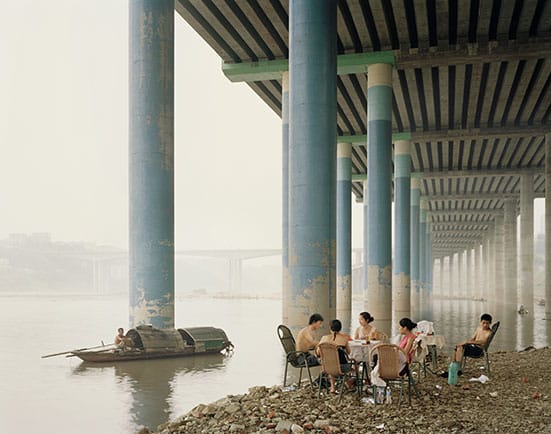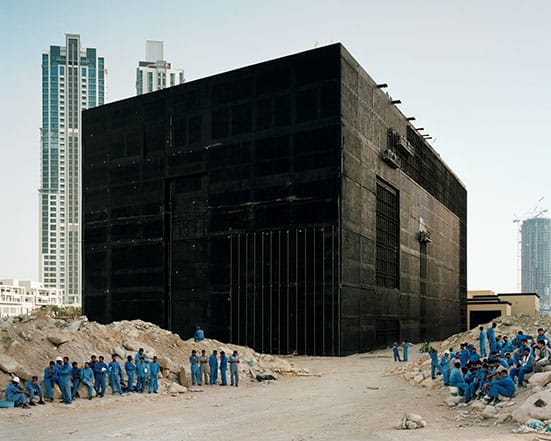25th September 2014 — 11th January 2015
This exhibition brings together eighteen fantastic artists who explore the built environment through a camera lens. This isn’t ‘architectural photography’ in the sense of a flattering, generic image of a building used for marketing. This is a fascinating record of how photography can frame a view, document a changing condition or provide a commentary on wider social issues. This is Photography as Art, as Anthropology, as social critique.
The obvious photographers of architecture are here, Helene Binet with her ethereal abstract images of the Jewish Museum, Lucien Hervé, Corbusier’s photographic consort at Chandigarh and Julius Shulman’s magazine perfect lifestyle images of Californian modernism. As an architect, I am quite familiar with these photographs and although they are wonderful to see, for me these are the least interesting offering here. After all, this exhibition is stuffed full of intelligent, beautiful and challenging work that connects architecture and photography in unusual ways.
The photographers in this exhibition employ diverse techniques and aesthetics. Each distorts their architectural subjects through repetition, choreography, or even Photoshop. Andreas Gursky in his work Sao Paulo, Sé digitally distorts the image to create a layered pattern that turns Sao Paulo station into a subterranean temple to speed. Using a different technique Ed Ruscha takes images of empty parking lots from a helicopter eliminating all sense of spatial depth. The parking lots become a series of abstract geometric patterns. These photographs are not concerned with honesty but evoke a character or atmosphere of architecture.
The most moving work for me is the work which documents our changing environment. Nadav Kander’s otherworldly images follow the length of the Yangtze River to show how ambitious architectural fantasy collides with reality. The works show what appear to be fantastical landscapes but on closer inspection reveal people engaged in traditional riverbank activities such as picnicking or swimming against a backdrop of vast industrial or concrete structures.
Simon Norfolk’s stunning photographs from the series Burke + Norfolk (2010 – 11) focus on the devastation of war in Afghanistan. As the wall text explains, Norfolk’s ‘sublime post-apocalyptic landscapes communicate the impermanence of civilizations as memorialized through architecture — revealing an historical layering of different occupying powers — as well as our fetishization of the architectural and cultural ruin.’ Shot in pre-dawn or post-sunset light the images have a blue palette that point to Norfolk’s ‘disappointment and disillusionment with what has happened’. In this haunting body of work Norfolk focuses his camera on the emergence of a new urban landscape rising out from the rubble.
Bas Princen is concerned with the condition of the contemporary city. His images of Dubai strike a cord not only for their elegant composition but also for the inclusion of the exploited Indian workers lounging as insignificant human collateral around the mega structure they are building. In fact people are conspicuously absent in most of the other photographs on display. Princen’s carefully constructed photographs are both beautiful and desolate. They invite us to examine spatial conditions that are note-worthy not because they are extraordinary but because they are generic and omnipresent.
This is a haunting exhibition, asking us not only to think about the relationship between photography and the built environment, but about wider global issues, society and the world we live in. It is a wonderful collection of photographers, curated expertly. I defy you not to leave both moved and inspired.
Anja Funston
Barbican Art Gallery
Barbican Centre
Silk Street
London EC2Y 8D
http://www.barbican.org.uk/artgallery/
Open
Daily, 11am-8pm
Late night first Thurs, 11am-10pm

Hélène Binet
Jewish Museum Berlin, Daniel Libeskind, Untitled 9, July 1997.
Courtesy of Hélène Binet

Nadav Kander
Chongqing IV (Sunday Picnic), Chongqing Municipality, 2006
© Nadav Kander, courtesy Flowers Gallery.

Simon Norfolk
A security guard's booth at the newly restored Ikhtiaruddin citadel, Herat, 2010 - 2011.
Courtesy of Simon Norfolk

Bas Princen
Cooling Plant, Dubai, 2009.
Courtesy of Bas Princen